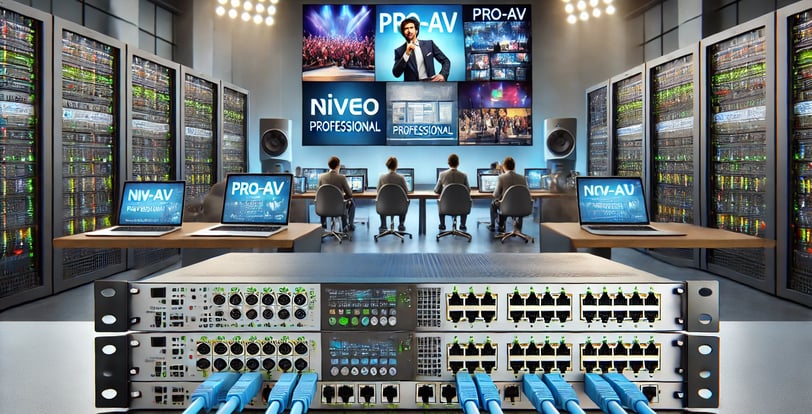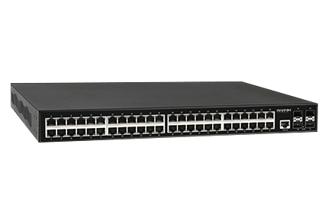Maximizing AV Performance: The Role of High-Bandwidth Networking
#AVCentricNetworking #Avixa, #Cedia, #AVNU, #SDVoE #AVoIP #AVoverIP #proav #AVTweeps
Arthur de Jager - Niveo Professional
8/8/20246 min read


Maximizing AV Performance: The Role of High-Bandwidth Networking
Introduction
In the rapidly evolving field of professional audio-visual (Pro-AV) integration, delivering exceptional performance is paramount. Whether it’s a corporate conference, a live concert, or a digital signage network, the quality and reliability of AV systems can make or break the user experience. One critical factor that significantly influences AV performance is the underlying network infrastructure, particularly the bandwidth capabilities. This blog explores the importance of high-bandwidth networking in maximizing AV performance and provides practical insights for Pro-AV integrators to optimize their setups.
Understanding Bandwidth in AV Networks
Bandwidth refers to the maximum rate at which data can be transferred over a network. In the context of AV systems, bandwidth is essential for transmitting high-definition video, multi-channel audio, and real-time data without delays or interruptions. As AV content becomes increasingly data-intensive—think 4K and 8K video, high-fidelity audio, and interactive media—the demand for higher bandwidth grows.
Key components affected by bandwidth:
Video Transmission: High-definition and ultra-high-definition video streams require substantial bandwidth to maintain quality and fluidity.
Audio Transmission: Multi-channel audio, especially in professional sound systems, demands reliable bandwidth to prevent dropouts and latency issues.
Control Data: Real-time control signals for devices such as cameras, microphones, and lighting systems must be transmitted without delays.
The Impact of Insufficient Bandwidth
When a network lacks sufficient bandwidth, it can lead to several performance issues, including:
Video Lag and Buffering: Insufficient bandwidth can cause video streams to lag or buffer, disrupting the viewing experience.
Audio Dropouts: Limited bandwidth may result in audio dropouts, where parts of the audio signal are lost, affecting sound quality.
Synchronization Issues: Audio and video may fall out of sync, creating a disjointed experience for the audience.
Network Congestion: Overloaded networks can slow down data transmission, affecting all connected devices and applications.
High-Bandwidth Networking Solutions
To address these challenges, Pro-AV integrators need to implement high-bandwidth networking solutions that can handle the demands of modern AV systems. Here are some strategies to consider:
1. Utilize High-Performance Switches Investing in high-performance network switches is crucial for managing AV traffic efficiently. Look for switches that support Gigabit Ethernet or higher to ensure adequate bandwidth for all connected devices.
2. Implement Quality of Service (QoS) QoS is a feature that prioritizes certain types of network traffic, ensuring that critical AV data is transmitted without delay. By configuring QoS settings on network switches, integrators can prioritize audio and video streams over less critical data.
3. Use VLANs for Network Segmentation Virtual LANs (VLANs) allow you to segment your network into smaller, isolated sections. This can help manage bandwidth more effectively by separating AV traffic from other network traffic, reducing congestion and improving performance.
4. Opt for Fiber Optic Cabling Fiber optic cables offer significantly higher bandwidth compared to traditional copper cables. They are ideal for long-distance data transmission without signal degradation, making them a preferred choice for large-scale AV installations.
5. Monitor Network Performance Regularly monitoring network performance can help identify and address potential bandwidth issues before they impact AV performance. Use network management tools to track bandwidth usage and detect bottlenecks.
The Future of High-Bandwidth Networking in AV
As AV technology continues to advance, the demand for higher bandwidth will only increase. Emerging trends such as 8K video, virtual reality (VR), and augmented reality (AR) are set to push the limits of network infrastructure. Pro-AV integrators must stay ahead of these trends by adopting future-proof networking solutions that can scale with evolving requirements.
Emerging technologies driving bandwidth demand:
8K Video: With four times the resolution of 4K, 8K video requires significantly more bandwidth to deliver pristine image quality.
Virtual Reality (VR) and Augmented Reality (AR): These immersive technologies depend on high-bandwidth networks to transmit large amounts of data in real-time.
Interactive and Smart Displays: As displays become more interactive and integrated with smart technologies, the need for robust bandwidth increases to support seamless user interactions.
Real-World Applications of High-Bandwidth Networking
To illustrate the impact of high-bandwidth networking, let’s explore some real-world applications and how they benefit from robust network infrastructure:
1. Corporate Conferencing In a corporate environment, high-bandwidth networking ensures that video conferencing systems operate smoothly, with high-definition video and clear audio. This enables effective communication and collaboration, even in large organizations with multiple locations.
2. Live Events For live events, such as concerts or sports broadcasts, high-bandwidth networks are essential for transmitting high-quality video and audio to large screens and sound systems. This ensures that audiences enjoy an immersive experience without interruptions.
3. Educational Institutions Educational institutions rely on high-bandwidth networks to support interactive learning tools, online lectures, and digital classrooms. This enables educators to deliver engaging and effective instruction, regardless of whether students are on-site or remote.
4. Digital Signage In retail, transportation hubs, and other public spaces, digital signage depends on high-bandwidth networks to display dynamic content. This can include high-resolution videos, real-time updates, and interactive elements, all of which require reliable data transmission.
Practical Tips for Pro-AV Integrators
To maximize AV performance through high-bandwidth networking, Pro-AV integrators should consider the following practical tips:
1. Assess Bandwidth Requirements Start by assessing the bandwidth requirements of your AV system. Consider the types of content you’ll be transmitting and the number of devices connected to the network.
2. Choose the Right Hardware Select network switches, routers, and cabling that support the necessary bandwidth for your applications. Look for equipment with features such as QoS, VLAN support, and high-speed ports.
3. Plan for Scalability Design your network with scalability in mind. As your AV system grows, your network should be able to accommodate additional devices and increased data traffic without compromising performance.
4. Conduct Regular Maintenance Regularly maintain and update your network equipment to ensure optimal performance. This includes updating firmware, monitoring network traffic, and addressing any issues promptly.
5. Collaborate with Network Experts Consider collaborating with network experts or consultants who specialize in high-bandwidth networking. Their expertise can help you design and implement a network that meets the specific needs of your AV system.
Conclusion
High-bandwidth networking is the foundation of modern Pro-AV systems, enabling the seamless transmission of high-definition video, multi-channel audio, and real-time data. By understanding the role of bandwidth and implementing strategies to optimize network performance, Pro-AV integrators can deliver exceptional AV experiences. As technology continues to evolve, staying ahead of bandwidth demands will be crucial for success in the Pro-AV industry. Integrators looking to enhance their network performance should consider exploring high-performance networking solutions to meet the growing demands of today's AV systems.
How Niveo Professional Switches Helps Maximizing AV Performance
Niveo Professional switches are designed to meet the high demands of modern Pro-AV systems, ensuring that every component operates at its best. By providing high bandwidth capacity, these switches support the seamless transmission of high-definition video, multi-channel audio, and real-time data. This is crucial for maintaining the quality and fluidity of AV content, preventing issues like video lag, audio dropouts, and synchronization problems. With advanced Quality of Service (QoS) features, Niveo switches prioritize critical AV traffic, ensuring that essential data is transmitted without delay, thereby enhancing the overall performance and reliability of the AV system.
Moreover, Niveo Professional switches come equipped with robust hardware and redundancy features, such as link aggregation and failover protocols, which ensure continuous network operation even in the event of a hardware failure. Their support for Power over Ethernet (PoE) simplifies the installation process and reduces the need for additional power supplies, making it easier to manage and power various AV devices. Enhanced security features protect the network from unauthorized access and cyber threats, ensuring the integrity and safety of AV communications. By integrating Niveo Professional switches into their setups, Pro-AV integrators can achieve superior performance, reliability, and security, thereby maximizing the potential of their AV systems.
About Niveo Professional
Niveo Professional is a leading manufacturer of Network Equipment for pro-AV. A pioneer in the industry, that has brought many innovations to make life of the Integrator Easy!
About Arthur de Jager
Arthur de Jager is co-founder of Niveo Professional, Entrepreneur and author and active in the AV-industry for over 30 Years.






